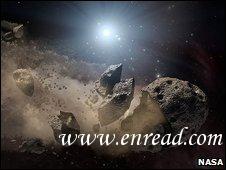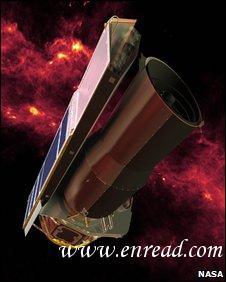Rocky clues from dirty dead stars 从死恒星获得的岩石信息
(单词翻译:单击)
A survey of dead stars has found that many are probably surrounded by the rocky remains1 of asteroids2 and planets.
一项对于死行星的调查发现,很多死恒星周围很可能围绕着小行星和行星上的残余岩石。
As rock is drawn3 in towards the star, it would be torn apart
The discovery comes from a Spitzer space-telescope study of white dwarfs5(白矮星) - the fading embers(馀烬) of burnt-out stars.
Astronomers6 showed at least one in 100 of these objects has "surface" layers that are contaminated with elements such as calcium7 and magnesium8(镁).
They say the elements could only have come from rocky debris(碎片,残骸) that was constantly raining down on the stars.
"We used Spitzer to study these white dwarfs and look for elements that shouldn't be there and we found that a very significant fraction(分数,破片) of them had closely orbiting dust right on top of them," said Dr Jay Farihi of the University of Leicester, UK.
"We see this phenomenon 1-3% of the time, so we infer that main sequence stars(烛星) similar to our Sun - or perhaps just a little bit bigger - have terrestrial planets(类地行星) 1-3% of the time."
Dr Farihi told BBC News: "In our galaxy9, a very rough estimate would be that there are five million white dwarfs with left-over rocky planetary material."
The orbiting Spitzer telescope looks at the cosmos10 in the infrared11
Pollution signature
Just how many stars out there might harbour terrestrial planets, like an Earth or a Mars, is an open question because the technology needed to detect them directly is only now becoming available.
Until astronomers can routinely identify them, indirect methods must be used to infer the planets' existence - such as with the Spitzer study.
Spitzer is the US space agency's (Nasa) infrared(红外的) orbiting observatory12.
It is tuned13 to see the longer wavelengths14(波长) of light emanating15(散发,发出) from cooler objects, such as the compact white dwarf4 stars that have ended their main hydrogen- and helium(氦)-burning phase and blown off their outer layers.
These objects tend to be about the mass of our Sun but encapsulated(压缩) in a body no bigger than the Earth. Their strong gravity(重力) pulls any heavier elements that are present to the core, leaving just the very light elements of hydrogen and helium to float on top.
But, occasionally, scientists do see the signatures of heavier elements persisting at the surface; and the only way to explain this is if material is continually being drawn down on to the white dwarfs.
The model constructed by Dr Farihi and colleagues to explain Spitzer's latest observations suggests planets in orbit around the dead stars are disrupting smaller objects, hurling16 them towards the dwarfs.
Planet hunting
Close in, these rocks are broken up by gravitational tides (the same phenomenon which led to the creation of Saturn's rings 土星环) to form dusty discs that feed the pollution.
"We see heavy elements," said Dr Farihi. "Calcium is the main one, but we also see magnesium and iron.
"These are typical of rocks. They're not typical of, say, interstellar clouds(星际云) which are rich in hydrogen and volatile17(反复无常的,挥发的) elements such as carbon and helium. It's not a definitive18 conclusion but it's pretty supportive of the idea that this material is rocky."
Dr Farihi said dirty white dwarfs would be excellent places to go looking for Earth-sized planets once the detection technology matures. However, he cautioned that worlds that circle dead stars would not be very interesting places.
"They're not going to harbour water and they're not going to be great sites for habitability(可居住). But they may have been habitable previously19 and perhaps life did get started on them. It's speculation20(沉思,推测), and the outlook for such things is bleak(萧瑟的,严寒的)," Dr Farihi said.
The researcher was presenting the discovery here at the European Week of Astronomy and Space Science conference at the University of Hertfordshire.
 收听单词发音
收听单词发音
1
remains

|
|
| n.剩余物,残留物;遗体,遗迹 | |
参考例句: |
|
|
|
2
asteroids

|
|
| n.小行星( asteroid的名词复数 );海盘车,海星 | |
参考例句: |
|
|
|
3
drawn

|
|
| v.拖,拉,拔出;adj.憔悴的,紧张的 | |
参考例句: |
|
|
|
4
dwarf

|
|
| n.矮子,侏儒,矮小的动植物;vt.使…矮小 | |
参考例句: |
|
|
|
5
dwarfs

|
|
| n.侏儒,矮子(dwarf的复数形式)vt.(使)显得矮小(dwarf的第三人称单数形式) | |
参考例句: |
|
|
|
6
astronomers

|
|
| n.天文学者,天文学家( astronomer的名词复数 ) | |
参考例句: |
|
|
|
7
calcium

|
|
| n.钙(化学符号Ca) | |
参考例句: |
|
|
|
8
magnesium

|
|
| n.镁 | |
参考例句: |
|
|
|
9
galaxy

|
|
| n.星系;银河系;一群(杰出或著名的人物) | |
参考例句: |
|
|
|
10
cosmos

|
|
| n.宇宙;秩序,和谐 | |
参考例句: |
|
|
|
11
infrared

|
|
| adj./n.红外线(的) | |
参考例句: |
|
|
|
12
observatory

|
|
| n.天文台,气象台,瞭望台,观测台 | |
参考例句: |
|
|
|
13
tuned

|
|
| adj.调谐的,已调谐的v.调音( tune的过去式和过去分词 );调整;(给收音机、电视等)调谐;使协调 | |
参考例句: |
|
|
|
14
wavelengths

|
|
| n.波长( wavelength的名词复数 );具有相同的/不同的思路;合拍;不合拍 | |
参考例句: |
|
|
|
15
emanating

|
|
| v.从…处传出,传出( emanate的现在分词 );产生,表现,显示 | |
参考例句: |
|
|
|
16
hurling

|
|
| n.爱尔兰式曲棍球v.猛投,用力掷( hurl的现在分词 );大声叫骂 | |
参考例句: |
|
|
|
17
volatile

|
|
| adj.反复无常的,挥发性的,稍纵即逝的,脾气火爆的;n.挥发性物质 | |
参考例句: |
|
|
|
18
definitive

|
|
| adj.确切的,权威性的;最后的,决定性的 | |
参考例句: |
|
|
|
19
previously

|
|
| adv.以前,先前(地) | |
参考例句: |
|
|
|
20
speculation

|
|
| n.思索,沉思;猜测;投机 | |
参考例句: |
|
|
|
- 上一篇:Pancreatic cancer therapy 'hope' 胰腺癌治疗现“希望”
- 下一篇:生孩子影响婚姻质量? Unhappy marriage? Blame the kids, claims eight-year study






